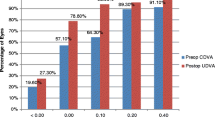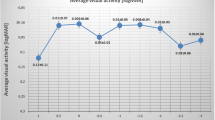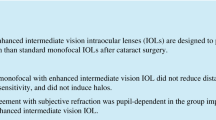Abstract
The purpose of this study was to evaluate the early visual and refractive outcomes of a new aspheric monofocal microincision intraocular lens (IOL). This retrospective case series included eyes of patients who underwent implantation of a microincision IOL following 1.8 mm manual coaxial microincision cataract surgery and who attended regular postoperative follow-up visits on the first week and first, third, and sixth months. The postoperative uncorrected visual acuity (UCVA), best corrected visual acuity (BCVA), refraction and predictability, intraoperative and postoperative complications, posterior capsule opacification (PCO), IOL centration, and surgically induced astigmatism (SIA) were evaluated. Sixty-three eyes of 38 patients ranging in age from 51 to 86 were included in the study. The mean preoperative BCVA was 0.52 ± 0.42 logMAR. At the postoperative sixth month, the mean postoperative UCVA and BCVA were 0.12 ± 0.11 and 0.01 ± 0.03 logMAR, respectively. The mean postoperative spherical equivalent refraction (SER) was −0.30 ± 0.49 D. The SER was within ± 1.00 D of the attempted correction in 95.2 % of the eyes. The mean SIA measured with vector analysis was 0.45 ± 0.28 D. Mild PCO was observed in 9 eyes (14.7 %) with none requiring Nd:Yag laser capsulotomy. On centration analysis, the IOL was found to be 0.26 mm on average to the supero-nasal position. The aspheric microincision IOL was safely implanted and provided satisfactory visual and refractive outcomes in the early postoperative period.





Similar content being viewed by others
References
Alio JL, Rodriguez-Prats JL, Galal A (eds) MICS; Micro-incision Cataract Surgery. Panama, Highlights of Ophthalmology International, 2004
Osher RH (2007) Microcoaxial phacoemulsification Part 2: clinical study. J Cataract Refract Surg 33:408–412
Vasavada V1, Vasavada V, Raj SM, Vasavada AR (2007) Intraoperative performance and postoperative outcomes of microcoaxial phacoemulsification; observational study. J Cataract Refract Surg 33:1019–1024
Hayashi K, Yoshida M, Hayashi H (2009) Postoperative corneal shape changes: microincision versus small-incision coaxial cataract surgery. J Cataract Refract Surg 35:233–239
Cleary G, Spalton DJ, Hancox J, Boyce J, Marshall J (2009) Randomized intraindividual comparison of posterior capsule opacification between a microincision intraocular lens and a conventional intraocular lens. J Cataract Refract Surg 35:265–272
Prakash P, Kasaby HE, Aggarwal RK, Humfrey S (2007) Microincision bimanual phacoemulsification and Thinoptx implantation through a 1.70 mm incision. Eye 21:177–182
Alió JL, Rodriguez-Prats JL, Vianello A, Galal A (2005) Visual outcome of microincision cataract surgery with implantation of an Acri. Smart lens. J Cataract Refract Surg 31:1549–1556
Can I, Takmaz T, Bayhan HA, Bostancı Ceran B (2010) Aspheric microincision intraocular lens implantation with biaxial microincision cataract surgery: efficacy and reliability. J Cataract Refract Surg 36:1905–1911
Alió JL, Piñero DP, Ortiz D, Montalbán R (2009) Clinical outcomes and postoperative intraocular optical quality with a microincision aberration-free aspheric intraocular lens. J Cataract Refract Surg 35:1548–1554
Wolffsohn JS, Buckhurst PJ (2010) Objective analysis of toric intraocular lens rotation and centration. J Cataract Refract Surg 36:778–782
Tetz MR, Auffarth GU, Sperker M, Blum M, Völcker HE (1997) Photographic image analysis system of posterior capsule opacification. J Cataract Refract Surg 23:1515–1520
Toygar B, Yabas Kiziloglu O, Toygar O, Aykan U (2015) Spontaneous haptic flexion and misalignment of a new microincisional aspheric intraocular lens in the early postoperative period in two patients. J Refract Surg 31:558–560
Chylack LT Jr, Wolfe JK, Singer DM, Leske MC, Bullimore MA, Bailey IL, Friend J, McCarthy D, Wu SY (1993) The lens opacities classification system III. The longitudinal study of cataract study group. Arch Ophthalmol 111:831–836
von Sonnleithner C, Bergholz R, Gonnermann J, Klamann MK, Torun N, Bertelmann E (2015) Clinical results and higher-order aberrations after 1.4-mm biaxial cataract surgery and implantation of a new aspheric intraocular lens. Ophthalmic Res 53:8–14
Yu AY, Wang QM, Sun J, Xue AQ, Zhu SQ, Wang SL, Li JY (2009) Spherical aberration after implantation of an aspheric versus a spherical intraocular lens in high myopia. Clin Exp Ophthalmol 37:558–565
Nochez Y, Majzoub S, Pisella PJ (2010) Effects of spherical aberration on objective optical quality after microincision cataract surgery. J Fr Ophtalmol 33:16–22
Nanavaty MA, Spalton DJ, Gala KB, Dhital A, Boyce J (2013) Fellow-eye comparison of posterior capsule opacification between 2 aspheric microincision intraocular lenses. J Cataract Refract Surg 39:705–711
Wilczynski M, Supady E, Loba P, Synder A, Palenga-Pydyn D, Omulecki W (2011) Evaluation of surgically induced astigmatism after coaxial phacoemulsification through 1.8 mm microincision and standard phacoemulsification through 2.75 mm incision. Klin Oczna 113:314–320
Wilczynski M, Supady E, Piotr L, Synder A, Palenga-Pydyn D, Omulecki W (2009) Comparison of surgically induced astigmatism after coaxial phacoemulsification through 1.8 mm microincision and bimanual phacoemulsification through 1.7 mm microincision. J Cataract Refract Surg 35:1563–1569
Buehl W, Findl O (2008) Effect of intraocular lens design on posterior capsule opacification. J Cataract Refract Surg 34:1976–1985
Kugelberg M, Wejde G, Jayaram H, Zetterstrom C (2006) Posterior capsule opacification after implantation of a hydrophilic or a hydrophobic acrylic intraocular lens; one-year follow-up. J Cataract Refract Surg 32:1627–1631
Pande MV, Ursell PG, Spalton DJ, Heath G, Kundaiker S (1997) High-resolution digital retroillumination imaging of the posterior lens capsule after cataract surgery. J Cataract Refract Surg 23:1521–1527
Spyridaki M, Höh H (2010) Comparison of four MICS intraocular lenses regarding their rates of neodymium:yAG laser capsulotomy. Klin Monbl Augenheilkd 227:208–214
Cavallini GM, Masini C, Campi L, Pelloni S (2008) Capsulorhexis phimosis after bimanual microphacoemulsification and in-the-bag implantation of the Akreos MI60 intraocular lens. J Cataract Refract Surg 34:1598–1600
Mak ST, Wong AC, Tsui WM, Tse RK (2008) Calcification of a hydrophilic acrylic intraocular lens: clinicopathological report. J Cataract Refract Surg 34:2166–2169
Baumeister M, Bühren J, Kohnen T (2009) Tilt and decentration of spherical and aspheric intraocular lenses: effect on higher order aberrations. J Cataract Refract Surg 35:1006–1012
Buckhurst PJ, Wolffsohn JS, Naroo SA, Davies LN (2010) Rotational and centration stability of an aspheric intraocular lens with a simulated toric design. J Cataract Refract Surg 36:1523–1528
Crnej A, Hirnschall N, Nishi Y et al (2011) Impact of intraocular lens haptic design and orientation on decentration and tilt. J Cataract Refract Surg 37:1768–1774
Author information
Authors and Affiliations
Corresponding author
Ethics declarations
Ethical standards
Ethical committee approval was obtained for this study. All procedures performed in the study involving human participants were in accordance with the ethical standards of the institutional and/or national research committee and with the 1964 Helsinki declaration and its later amendments or comparable ethical standards. For this type of study (retrospective case series), formal consent is not required. This article does not contain any studies with animals performed by any of the authors
Conflict of interest
The authors declare that they have no conflict of interest related to the submitted study. Outside the submitted study, BT has financial support for attending symposia from BAUSCH & LOMB, MOSS VISION, and ALCON and has personal fees from STAAR. OYK has financial support for attending symposia from ALCON; OT has financial support for attending symposia from BAUSCH & LOMB.
Rights and permissions
About this article
Cite this article
Toygar, B., Yabas Kiziloglu, O., Toygar, O. et al. Early clinical outcome with a new monofocal microincision intraocular lens. Int Ophthalmol 36, 657–664 (2016). https://doi.org/10.1007/s10792-016-0178-7
Received:
Accepted:
Published:
Issue Date:
DOI: https://doi.org/10.1007/s10792-016-0178-7




